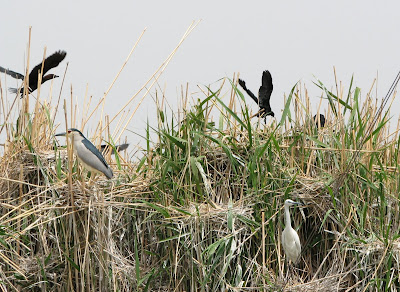What makes the fisheries special is the amount and diversity of water birds there. After some other lakes in Armenia were drained or the habitat around them destroyed as a result of human activity, the birds started making their nests at the fisheries, which are surrounded by reeds and are rich with food. Beside the ducks, herons and egrets, terns and cormorants of all shapes and sizes, that are fairly common (even though some of those are threatened too,) there are some spectacular birds that live here – spoonbill, glossy ibis and black stork, for example. Pelicans and flamingos, that are not native to Armenia, stop over at the lakes during their migration.
Seeing as the lakes are practically the last resort for these birds in Armenia, you would think this a wonderful opportunity to dedicate at least part of the vast territory of the fisheries to a bird sanctuary, close it to hunting and fishing and open to kids, families and birdwatchers. Not so fast! The government does not seem in the least bit interested in stepping in, and the owner of the land, it seems, couldn't care less about endangered species (let me put it this way - he is yet to prove that he does). All that matters is that these birds eat fish. He grows fish for profit, and they eat it! So, without further ado, he sets to destroy them every which way he can. Besides regularly burning the reeds with nests, eggs and babies, he also allows an Italian-Armenian joint venture tour company to bring over groups of hunters to shoot the birds and has his own people shooting them as well, as they proudly boasted to us while we were walking around the lake. “They eat fish” said the young man with a gun showing us a shot black crowned night heron, a squacco heron and a duck.
The zoologists approached the owner of the fisheries more than once, asking him to stop allowing hunters to the lakes, but the answer still stands as negative. By the most optimistic predictions, it won't take long until the birds stop returning to these ponds, and will move to our southern neighbors for permanent residence. If they don't disappear altogether.
Sad.




